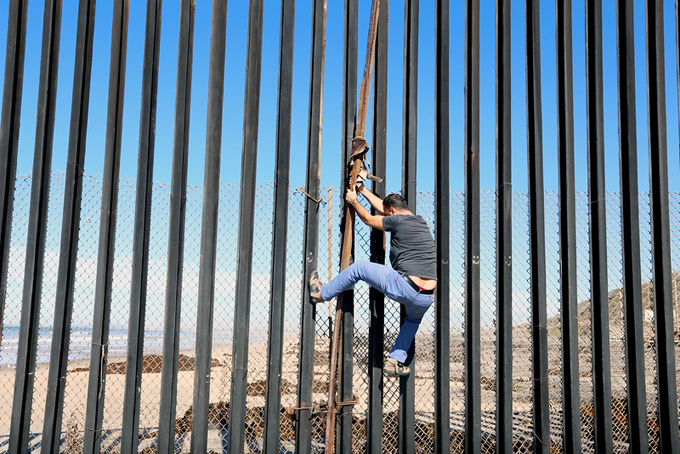
Tijuana. Photo courtesy of Lualicia Unibe.
On January 27, Khaled Jarrar set out on an uncommon journey: traveling in a 34-foot RV from San Diego, California, to Juarez, Mexico, crisscrossing and following the U.S.-Mexico border along the way. Jarrar was traveling as part of Culturunners, a project initiated by Edge of Arabia in partnership with Art Jameel, in which artists travel from place to place in order to explore contested boundaries. On the journey the group encountered border patrol agents on both sides of the border, met and worked with locals living near the border, and organized talks at galleries and public spaces. During his time on the road, Jarrar created and installed a new work, Khaled’s Ladder, using material pulled from the border fence. Coming from his home in the West Bank, where the Israeli separation wall shapes daily life and restricts freedom of movement, Khaled was alert to the ways in which the U.S.–Mexico border informs the experiences of those who live on either side of it. After completing the RV journey to Juarez, Khaled made the trip to New York and visited the Creative Time offices, where he talked to Creative Time Reports’ associate editor, Rachel Riederer, about his new work and his ongoing interest in dismantling walls and crossing borders.
Creative Time Reports (Rachel Riederer, associate editor): Your recent trip along the border was your first visit to the United States, correct? What happened when you tried to come here before?
Khaled Jarrar: On July 13, 2014, I went to cross the Allenby Bridge at the border of the West Bank with Jordan—the only passage for Palestinians from the region traveling to other parts of the world. From there, I was going to fly to New York from the Amman airport. Actually the struggle began even before the bridge. When I got the invitation from the New Museum in New York to participate in the exhibition Here and Elsewhere, I needed to go to Jerusalem for an interview at the American consulate to get a visa. And Jerusalem is separated from Ramallah, where I live, by the Israeli separation wall, so I needed to get permission from the Israeli Army to cross into Jerusalem. I applied, but they didn’t give me permission. So I had to cross the wall and smuggle myself into Jerusalem for the interview at the consulate.
Anyway I made it. I got the visa, and then I drove to the bridge to cross into Jordan. When I arrived at Israeli border control at the bridge, the agent took my passport and said, “You need to go back; you are not allowed to leave.” So basically I was not allowed to leave my hometown, my country.
CTR: But you were able to leave for this visit?
KJ: Yes. I was banned from traveling for two months. The Israelis said it was for security reasons, but they had no reasons actually. It was just a kind of punishment or humiliation, a reminder that “we are here.” But they could not stop my voice, and I participated in the panel discussion at the museum via Skype, so my art is stronger than they are.
When Stephen Stapleton, the founding director of Edge of Arabia, invited me to work on this project, I was actually working on another film, this one about Syrian refugees. I worked with Syrian refugees in Greece; I walked with them on the whole trip as they made their way to Germany. I even had fake papers—some refugees had to buy these false papers giving them three days to walk to the nearest border, and I did the same. I was walking with them as a refugee, not as a cameraman but as a refugee with a camera. I accepted Stephen’s invitation because it is related to what I am doing: looking at border control, the wall—all these systems that separate people.
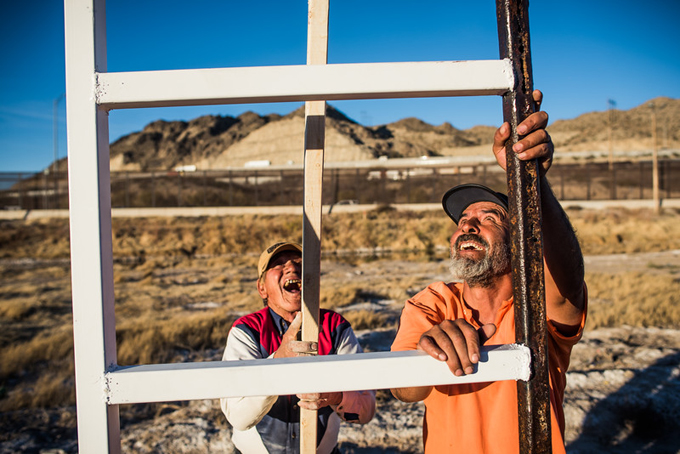
Texas. Photo by John Mireles, courtesy of Culturunners.
CTR: I’m sure that in your work along the US-Mexico border you saw some of the same systems at work that you have dealt with in Palestine. Can you talk about some of your experiences and the work you were doing there?
KJ: When I went to the wall in Tijuana, I saw all these people running, doing sports, doing yoga. People are just going about their lives, their daily lives. And the wall is in their face. What was most stunning to see was this one woman who was running up to the wall, and because the wall is made of metal bars, she could see what is behind it, but she couldn’t go there. So she was there practicing her yoga and looking at the USA—infiltrating it with her thoughts and ideas. Which was surreal for me.
At the wall I interviewed two women and one man. I asked one of the women why she came there and she said, “I want to smell the smell of my kids in America.” She has two boys and one girl in the USA, but she doesn’t have a green card, so she cannot visit her kids. She was crying when she was talking to me! It was like a woman I filmed in Palestine who was also crying about being separated from her child—her daughter lives on the other side of the wall, and she would talk with her daughter through the wall.
So these encounters gave me the energy to remove this piece from the U.S.–Mexico wall after I saw that it could be removed. I worked hard, and I succeeded in breaking it, and then I took it. There was a group of people nearby, and they took the piece in their big car. They helped us drive it to the RV.
My friend Laulicia, a Mexican artist who was helping and guiding us on our journey, told me that it was very emotional for her to see me doing this action. Because for them, as Mexicans, they never thought that they could touch the wall—it is untouchable. For them, this is taboo; this is something almost holy. She said she can’t touch it, can’t remove it. But after I removed it, she thought that I broke this holiness behind the wall. That is my work: I try to touch things and try to change their function and use them to make bridges between humans.
The purpose of the wall is to separate people and to stop people and to limit people from moving. And that’s why I made the ladder out of the rebar that I removed from the border wall—the ladder is a bridge to the other side. When you climb the ladder, it’s like Jacob’s Ladder. You have this ladder to go to heaven, to survive, to escape from misery. And people have the right to decide where to live or where to go, in spite of all these nations, territories and divisions.
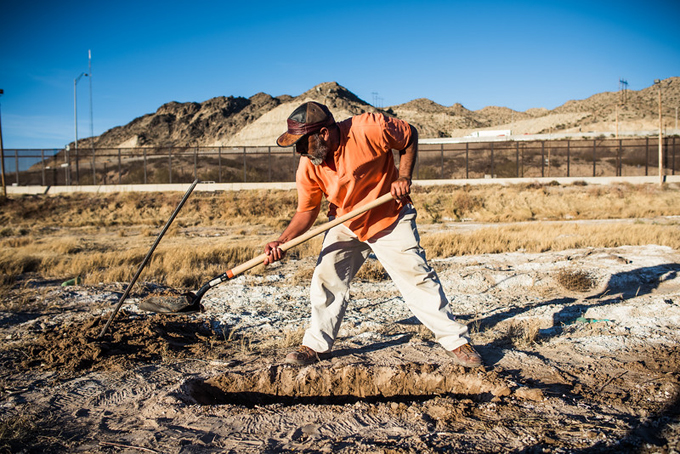
Texas. Photo by John Mireles, courtesy of Culturunners.
CTR: Did you ever feel that way about the wall in Palestine, that it was something inviolable that you could not touch?
KJ: In the beginning I was afraid to even think about removing any piece from the wall in Palestine, of course. But after being there for four years, filming every day and climbing across to meet my friends and go swim in the sea, this started to change. For example, once I was climbing the wall to go to the beach—because the beach in Tel Aviv is very close to where I live. When the weather is good, I can see the sea—but I can’t go there. So I needed to climb the wall and risk my life just to go to the beach to have a swim. So I did that. But this risk, it’s not about whether it’s worth risking for that day at the beach. It’s about the fact that I want to do it; I want to take the risk and enjoy my time on the beach.
So then I started meeting the other people who were crossing and hearing their stories. I was going to the beach. I met a man who was going to meet his wife. I met a woman who was going to meet her daughter, one man who was going to work, some small kids who were going to school. So the wall separates people from their schools, from their hospitals.
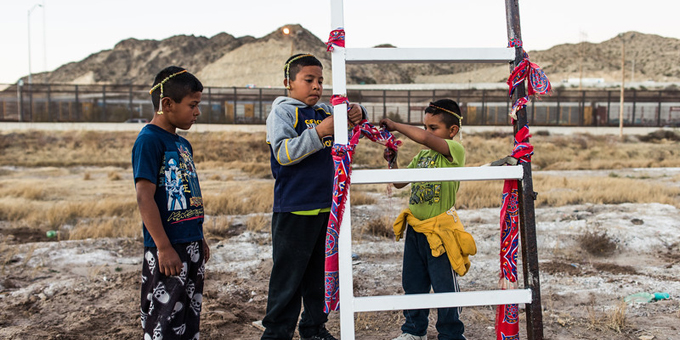
Photo by John Mireles, courtesy of Culturunners.
CTR: Can you talk about your experience when you encountered the federales when you were going along the U.S.–Mexico border. What happened when they stopped you?
KJ: I like to make a kind of testimony for this system and how it works, to unpeel and to understand it. So at one point we were on the Mexican side of the border, and I was looking through the holes in the wall, and there were the American border police on the other side of the wall, so I climbed the wall and was filming them. I was calling out, “Hi, how are you?” They were like 15 meters from me. Then they turned around to look at me. One of them put his hand to his gun, and then he removed his hand, and another agent started calling someone on the radio. They didn’t say hi, they didn’t respond, they just asked one question: “Where are you from?” Like they were thinking, “Who is this monkey who has climbed the wall and is filming?” Then in four or five minutes the Mexican federales came and said they had gotten a call from the American border patrol that I was climbing the wall. And I said, “Yeah, I was trying to climb it to see what is beyond. I am not jumping.” There is no sign saying you are not allowed to climb the wall. There are no signs saying that you are not allowed to cross the wall. There is just the wall.
The boss of the patrol was female. She was telling me stories of things she had seen. For example, two years ago the U.S. Border Patrol caught a boy who was trying to cross the wall, and after they caught him, they shot him to death. And by chance there was somebody filming, so that incident was on Facebook and YouTube. And this happens in Palestine as well. There was one case where Israeli border guards shot a Palestinian worker after they arrested him. He crossed the wall, and they shot him point-blank. This is the policy of terror that they try to spread inside the people’s minds and hearts. This is how people start to think that these things are untouchable—because this is the price: you may get shot.
CTR: And what happened when you arrived in Juarez?
KJ: The Mexican border agents were so suspicious of four guys coming with an RV to Juarez, they took us to the side and started asking where we were going, what were we doing. And then one of the agents saw in my passport the state of Palestine stamp that I had made. I designed this stamp in Arabic and English, with a picture of the jasmine flower and the Palestinian sunbird, our national bird. The agent asked me, “Is this a real stamp?” He said, “You are not allowed to make fake stamps in a passport.” And I said, “Yeah, but this is an art project!”
CTR: Just like you’re not allowed to climb the wall—but this is an art project.
KJ: Yes, exactly. So that is how I do it. I do it in the name of art, and I like how art gives us all this freedom and space to practice our creativity on the ground, not just on paper. This is how we can raise the questions and tell the stories that lead to solutions that will allow us to go beyond borders.
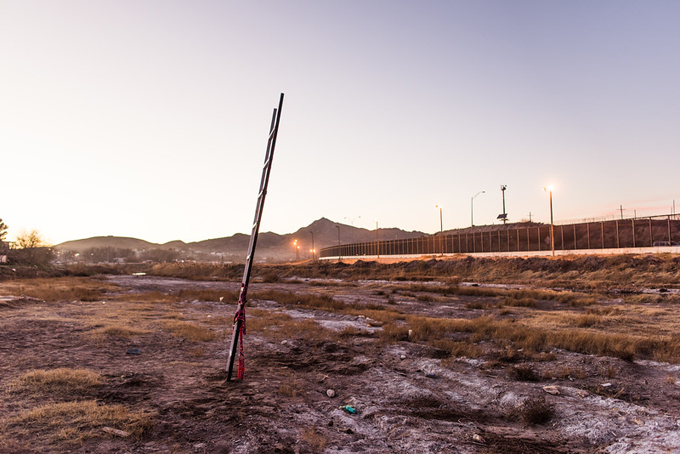
Photo by John Mireles, courtesy of Culturunners.

